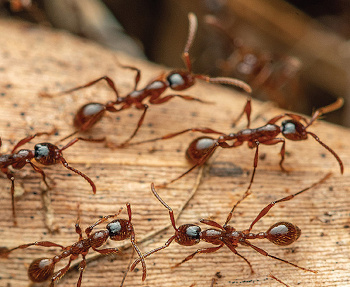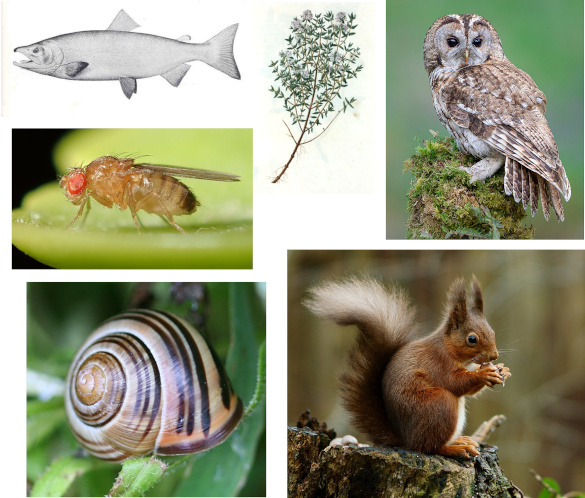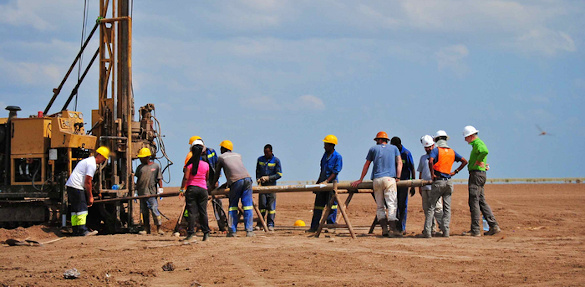Hominin Evolution
November 14, 2022
The relative
unimportance of
Earth on a
universal scale has been accentuated recently by the
first deep field image of the
James Webb Space Telescope. As if that wasn't
ego deflating enough, a recent
study estimates that the
ant population of the Earth is 20
quadrillion; that is, 20 x 10
15.[1-2] This estimate means that there are about 2.5 million ants for every
human. This reminds me of a
cartoon in which
space aliens deduced from their
observations of Earth that the
automobile was its
dominant species.[3]

Africa and Australasia are the home of driver ants of the genus Aenictus. These ants move quickly through forests in columns of thousands.
These particular ants were photographed on the Lockhart River in Queensland, Australia.
(Portion of a University of Würzburg image)
Nature has
surprises other than the vast
ratio of the number of ants to humans.
Birth gender in humans is determined at
conception, but the
sex of most
turtles,
crocodiles,
alligators, and
teleost fish depends on the
temperature at which their
eggs develop.[4-5] This
temperature-dependent sex determination means that turtle eggs
incubated below 27.7
°C (81.86
°F) produce
male turtles, while
female turtles will be produced above 31°V (88.8°F). A mix of sexes will be produced when temperatures
fluctuate between these extremes.[4]
Global warming will
skew turtle populations towards a higher female to male ratio.
Temperature-dependent sex determination differs from
genetic sex determination, but there's no question that Earth's
climate has induced changes in
evolution from
extinction and
genetic mutation driven by
adaptational to new climatic conditions. The
Chicxulub impact event about 66 million years ago caused the demise of 75% of living species and the eventual extinction of the
dinosaurs. It also allowed the rise of
mammals, perhaps aided by a
diversity of
plant species.[6] Closer to our time, climate change, such as the
ice ages, has affected species extinction.[7]
There have been five major ice ages, the earliest of these occurred about two billion years ago, long before the
advent of humans. The most recent ice age started about 2.6 million years ago, and we are presently in an
interglacial period of that age that began about 10,000 years ago. Since modern humans,
Homo sapiens, emerged about 300,000 years ago, our ancestors were alive during a
glacial period, as were our
cousin species, the
Neanderthals in
Europe and the
Denisovans in
Asia. The Neanderthals and the Denisovans appear to have gone extinct before the end of the glacial period. Humans arrived in
North America about 23,000 years ago, a time close to the peak of the glaciation.

Species known to be adapting to climate change.[8] From upper left, clockwise, sockeye salmon (Oncorhynchus nerka), thyme (Thymus vulgaris), tawny owl (Strix aluco), red squirrel (Sciurus vulgaris), banded snail (Cepaea hortensis), and fruit fly (Drosophila melanogaster).
(Images: sockeye salmon from the University of Washington, thyme from the New York Public Library, tawny owl by Barry Forbes, red squirrel by Peter Trimming, banded snail by S. Rae, and fruit fly by Alexis Orion, all from Wikimedia Commons. Click for larger image.)
To what extent has climate variation affected
human evolution? The demise of the Neanderthals and the Denisovans, possibly related to ice age conditions, was one factor, since it eliminated
competition from other
hominini. This might be attributed more to better adaptation by humans to climate change than a problem with our
Homo cousins. An in-depth study of factors affecting human evolution appeared in a 2010 report by the
United States National Research Council Committee on the Earth system Context for Hominin Evolution.[9] As stated in the introduction to this
report,
"This fossil record contains a history of critical evolutionary events that have ultimately shaped and defined what it means to be human, including the origins of bipedalism; the emergence of our genus Homo; the first use of stone tools; increases in brain size; and the emergence of Homo sapiens, more advanced tools, and culture. Some of these events appear to have coincided with major changes in African climate, raising the intriguing possibility that key junctures in human evolution and behavioral development may have been climatically mediated."[9]
In 1871,
Charles Darwin proposed that the reason that hominins became bipedal was a result of climate change that expanded African
grasslands, but this
theory still lacks sufficient
scientific evidence to be generally accepted.[9] However, the fossil record does contain evidence that climate change was associated not only with the emergence of our genus, Homo, but our first use of stone tools and increased brain size.[9] Genetic mutations beneficial to
survival in changing environment will proliferate in a species and become established.[9]
A huge
international team of
scientists has
published an
open access paper recently in
Nature Geoscience that examines how climate variability influenced hominin evolution in
eastern Africa during the
Pleistocene, a
geological epoch that ended 11,700 years ago.[10-11] Team members are from the
University of Cologne (Cologne, Germany), the
University of Science and Technology (Palapye, Botswana),
Addis Ababa University (Addis Ababa, Ethiopia), the
University of Oxford (Oxford, United Kingdom), the
University of Minnesota, Duluth (Duluth, Minnesota),
Aberystwyth University (Aberystwyth, United Kingdom), the
Berkeley Geochronology Center (Berkeley, California), the
University of Potsdam (Potsdam, Germany), the
University of Liverpool (Liverpool, United Kingdom), the
University of Bremen, (Bremen, Germany),
Eberhard Karls Universität (Tübingen, Germany), and the
University of Cambridge (Cambridge, United Kingdom).[10]
Numerous hominin fossils have been discovered in eastern Africa, but the climatic history of that region
concurrent with the creation of these fossils has been unknown.[11] This is particularly true for the
Pleistocene (Ice Age) epoch between 2,580,000 to 11,700 years ago.[11] The
Hominin Sites and Paleolakes Drilling Project (HSPDP) was started in 2008 to discover the climatic record by means of deep
core drilling operations in 2013–2014.[10] This project included more than 22 researchers from 19 institutions in 6
countries, and it was led by
Verena Foerster of the
Institute of Geography Education at the University of Cologne.[11]
Such a research
endeavor needs an
interdisciplinary team of
geoscientists,
sedimentologists,
paleontologists,
geologists,
geographers,
geochemists,
archaeologists,
chronologists, and
climate modelers.[11] As reported in their research paper, they extracted two continuous
sediment cores from which
microfossils and
elemental variations could be used as a means to reconstruct climatic history. Archaeologists,
evolutionary biologists, and
evolutionary anthropologists were then able to identify
phases of climatic
stress that changed human
habitats, influenced human
biological and cultural evolution and human
diaspora.[11]
The project included five drill sites in
Kenya and
Ethiopia that are located close to key
paleoanthropological sites representing various steps in human evolution.[11] The
Chew Bahir drilling site in southern Ethiopia covered the past 620,000 years, a period that includes the time when Homo sapiens emerged in Africa.[10-11] Two 280
meter cores were drilled from that site and their
analysis formed the basis of the paper.[10-11]

Recovering core sediments at the hew Bahir drilling site. In this photo, the day shift team is pulling the liner from a section of the 280 meter long core. (University of Cologne photo by Frank Schäbitz)
The first of three distinct phases of eastern Africa climatic variability coincided with the appearance of high
anatomical diversity in hominin groups in relatively stable
humid conditions from about 620,000 to 275,000 years ago with occasional abrupt and extreme hydroclimate
disturbances.[10-11] The second phase, from about 275,000 to 60,000 years ago cycled between
lush vegetation with deep
fresh water lakes to highly
arid landscapes.[10-11] In that phase, human tools transitioned to more complex
Middle Stone Age technologies accompanied by important human
social and cultural
innovations.[10-11] Says
lead author of the research paper, Verena Foerster,
"These innovations, such as more varied toolkits and long-distance transport, would have equipped modern humans with an unprecedented adaptability to the repeated expansions and contractions of habitats."[11]
The third phase, from 60,000 to 10,000 years ago had the most extreme climatic fluctuations and the most arid phase of the entire record.[11] Such conditions could have caused the continuous cultural changes seen in that period.[11] The research team believes that the concurrence of humid peaks in eastern Africa with wet phases in north-eastern Africa and the
Mediterranean created favorable
migration routes from Africa to facilitate the global dispersal of Homo sapiens.[11] Says Foerster,
"In view of current threats to the human habitat from climate change and the overuse of natural resources through human activity, understanding the relationship between climate and human evolution has become more relevant than ever."[11]
References:
- Patrick Schultheiss, Sabine S. Nooten, Runxi Wang, Mark K. L. Wong, François Brassard, and Benoit Guénard, "The abundance, biomass, and distribution of ants on Earth," Proc. Natl. Acad. Sci., vol. 119, no. 40 (September 19, 2022), Article no. e2201550119, https://doi.org/10.1073/pnas.2201550119.
- How many ants are there?, University of Würzburg, September 18, 2022.
- What on Earth! The Automobile Inherits the Planet, YouTube video by the National Film Board of Canada, posted by NextSTL, July 14, 2016.
- What causes a sea turtle to be born male or female?, National Oceanic and Atmospheric Administration (NOAA) website, June 15, 2022.
- Environmental Sex Determination, from S.F. Gilbert, "Developmental Biology, 6th edition," (Sinauer Associates, 2000).
- Elizabeth Pennisi, "How life blossomed after the dinosaurs died," Science, October 24, 2019, doi: 10.1126/science.aaz9741.
- Larisa R. G. DeSantis, Judith H. Field, Stephen Wroe, and John R. Dodson, "Dietary responses of Sahul (Pleistocene Australia–New Guinea) megafauna to climate and environmental change," Paleobiology, vol. 43, no. 2 (May, 2017), pp. 181-195, DOI: https://doi.org/10.1017/pab.2016.50.
- Helen Thompson, "Ten Species That Are Evolving Due to the Changing Climate," Smithsonian magazine, October 24, 2014.
- Understanding Climate’s Influence on Human Evolution, National Research Council (US) Committee on the Earth system Context for Hominin Evolution, (National Academies Press:Washington (DC), 2010).
- Verena Foerster, Asfawossen Asrat, Christopher Bronk Ramsey, Erik T. Brown, Melissa S. Chapot, Alan Deino, Walter Duesing, Matthew Grove, Annette Hahn, Annett Junginger, Stefanie Kaboth-Bahr, Christine S. Lane, Stephan Opitz, Anders Noren, Helen M. Roberts, Mona Stockhecke, Ralph Tiedemann, Céline M. Vidal, Ralf Vogelsang, Andrew S. Cohen, Henry F. Lamb, Frank Schaebitz, and Martin H. Trauth, "Pleistocene climate variability in eastern Africa influenced hominin evolution," Nature Geoscience, September 26, 2022, https://doi.org/10.1038/s41561-022-01032-y. This is an open access article with a PDF file here
- Key phases of human evolution coincide with flickers in eastern Africa's climate, University of Cologne Press Release, September 26, 2022.
Linked Keywords:
Importance; unimportance; Earth; universe; universal scale; first deep field image; James Webb Space Telescope; ego; research; study; estimation; estimate; ant; population ecology; standard dictionary numbers; quadrillion; human; cartoon; extraterrestrial life; space aliens; deductive reasoning; deduce; observation; automobile; dominance (ecology); dominant; species; Africa; Australasia; territory (animal); Dorylus; driver ant; genus; Aenictus; forest; column (formation); photograph; Lockhart River; Queensland, Australia; Nature; surprise (emotion); ratio; birth; gender; fertilisation; conception; sex; turtle; crocodile; alligator; teleost fish; temperature; egg; animal embryonic development; develop; temperature-dependent sex determination; egg incubation; incubated; Celsius; °C; Fahrenheit; °F; male; female; thermal fluctuation; fluctuate; global warming; skew normal distribution; genetic sex determination; climate; evolution; extinction; genetic mutation; adaptation; adaptational; Chicxulub crater; impact event; dinosaur; mammal; biodiversity; diversity; plant; ice age; advent; interglacial period; Homo sapiens; glacial period; cousin; Neanderthal; Europe; Denisovan; Asia; North America; adapting species; species; adapting; climate change; sockeye salmon (Oncorhynchus nerka); thyme (Thymus vulgaris); tawny owl (Strix aluco); red squirrel (Sciurus vulgaris); banded snail (Cepaea hortensis); fruit fly (Drosophila melanogaster); University of Washington; New York Public Library; Barry Forbes; Peter Trimming; S. Rae; Alexis Orion; Wikimedia Commons; human evolution; competition (biology); hominini; Homo; United States National Research Council; report; fossil record; history; bipedalism; genus; stone tool; brain size; tool; culture; coincidence; coincide; Charles Darwin; theory; propose; grassland; scientific evidence; survival of the fittest; international; scientist; scientific literature; publish; open access paper; Nature Geoscience; East Africa; Pleistocene; epoch (geology); geological epoch; University of Cologne (Cologne, Germany); University of Science and Technology (Palapye, Botswana); Addis Ababa University (Addis Ababa, Ethiopia); University of Oxford (Oxford, United Kingdom); University of Minnesota, Duluth (Duluth, Minnesota); Aberystwyth University (Aberystwyth, United Kingdom); Berkeley Geochronology Center (Berkeley, California); University of Potsdam (Potsdam, Germany); University of Liverpool (Liverpool, United Kingdom); University of Bremen, (Bremen, Germany); Eberhard Karls Universität (Tübingen, Germany); University of Cambridge (Cambridge, United Kingdom); concurrent; Pleistocene (Ice Age) epoch; core drilling; country; Verena Foerster; Institute of Geography Education; endeavor; interdisciplinarity; interdisciplinary; Earth science; geoscientist; sedimentology; sedimentologist; paleontology; paleontologists; geology; geologist; geographer; geochemistry; geochemist; archaeology; archaeologist; chronology; chronologist; climate model; climate modeler; core sample; sediment core; microfossil; chemical element; elemental; evolutionary biology; evolutionary biologist; evolutionary anthropology; evolutionary anthropologist; phase; biotic stress; habitat; biology; biological; diaspora; Kenya; Ethiopia; paleoanthropology; paleoanthropological; Lake Chew Bahir; meter; data analysis; Frank Schäbitz; anatomy; anatomical; humidity; humid; disturbance (ecology); lush; vegetation; fresh water; lake; arid; landscape; Middle Stone Age; technology; technologies; society; social; innovation; academic authorship; lead author; transport; Mediterranean Sea; early expansions of hominins out of Africa; migration routes from Africa; natural resource.